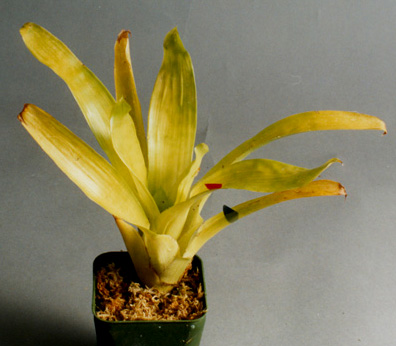A
catalogue of Bromeliads used for various projects by - © Lloyd Godman
This
is a catalogue of bromeliads used by Lloyd godman for his various installations
and photosynthesis projects - the collection of pants he accessed in
New Zealand from 1996 - 2004 was collected from a wide range of sources,
while most were brought from Greens Bromeliads, some were also donated
by the Dunedin Botanical Gardens. Later in 2004 these plants were either
sold or given away with his move to Australia.
Lloyd is at present re-establishing his collection where he now lives
in Melbourne.
A
Lexicon of Bromeliads: A
resource by Lloyd Godman
Genus - Aechmea: Sub- family - Bromelioideae: Family - Bromeliad
Generally,
Aechmeas form large urn shapes or tubular structures that hold reservoirs
of water, however there are also some smaller plants. Many are epiphytes that can adapt to growing in the ground, but they need a free draining soil. The leaves are often heavily marked with silver trichomes
and they produce colorful blooms which are short lived, but the inflorescence is long lasting. They are
found across a huge range of habitats in central and south America. Many are hardy plants and many can withstand cooler temperatures and dryer
conditions. Some have spectacular flowers which can last for months. If the flowers are pollinated the plant often forms colourful berries which contain an sticky jelly that is edible.
Plants are marked NZ for those collected in New Zealand - or Aust - for the new plants collected since coming to Australia
|
Aechmea filicaulis - NZ
|
|
|

|
Species/Cultivar: Species
Seed parent plant:
Pollen Parent Plant:
Taxonomic rank: Species
Hybridizer:N/A
Native distribution:This plant is found growing on trees and other supports only in the tropical cloud forest of Venezuela at altitudes of 300 - 4,800 ft
Habit: . It is a medium sized plant, that forms an open rosette with a shiny, soft green leaves that take on a bronze hue if grown in full light. The inflorescence is suspended on a long threadlike, branched flower stem that may hang from the plant for nearly 6ft. The bracts, which retain their brilliant colour for some time, are bright rosy red while the large petals are white and after flower it forms blue berries. The plant should be grown in a situation where the inflorescence can hang and where the breeze can catch the flowers, turning them into so many white butterflies.
Leaf shape:
Leaf cross section:
Pigmentation:
Spines:
Trichomes:
Axis:
Floral Bracts:
Rachis:
Bract on Stipe:
Primary Bract:
Internode:
Stipe:
Peduncle Bract:
Peduncle:
Inflorescence:
Flowers:
Petals:
Sepals:
Stamens:
Anther:
Stigma:
Pistil:
Pollen:
Roots:
Stalons:
Off sets:
Pollination:
Seed:
Germination:
Cultivation:
Fertilization:
Collection: NZ
|
|